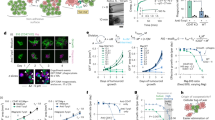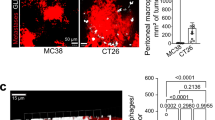Abstract
To investigate the site-specific implantation of cancer cells in peritoneal dissemination, we inoculated CDF1 mice intraperitoneally with mouse P388 leukaemia cells labelled with bromodeoxyuridine (BrdU) and then observed immunohistochemically the distribution of the cells in the greater omentum taken from the mice using an anti-BrdU antibody. We found the BrdU-labelled cells infiltrating selectively into the milky spots in the omentum. Furthermore, we intraperitoneally inoculated the BrdU-labelled P388 cells at 10(5), 10(6) and 10(7) cells per mouse into three groups of ten CDF1 mice and then quantified the distribution of the BrdU-labelled cells by counting the number of the labelled cells per unit area at each milky spot and non-milky spot site in the omentum. Inoculations of 10(5), 10(6) and 10(7) BrdU-labelled P388 cells per mouse resulted in 15.8 +/- 13.3, 120 +/- 46.5 and 504 +/- 208 cells mm-2 respectively in the milky spot sites and 9.14 x 10(-3) +/- 1.58 x 10(-2), 1.14 x 10(-1) +/- 7.82 x 10(-2) and 7.07 x 10(-1) +/- 5.98 x 10(-1) cells mm-2 respectively in the non-milky spot sites. The ratios of the mean labelled cell numbers in the milky spot sites vs those in the non-milky spot sites were 1728:1, 1049:1 and 713:1 respectively. In all cases, there were statistically significant differences in the number of BrdU-labelled cells mm-2 between milky spot sites and non-milky spot sites. However, the ratios decreased as the numbers of inoculated cells increased. In addition, we inoculated C57/BL mice intraperitoneally with B-16 PC melanoma cells, which were easily differentiated from the other cells by the intrinsic black melanin, and examined the distribution of the cells macro- and microscopically. The B-16 PC melanoma cells were also found to be infiltrating preferentially into the milky spots in the omentum. These results suggest that cancer cells seeded intraperitoneally specifically infiltrate the milky spots in the early stages of peritoneal dissemination.
This is a preview of subscription content, access via your institution
Access options
Subscribe to this journal
Receive 24 print issues and online access
$259.00 per year
only $10.79 per issue
Buy this article
- Purchase on Springer Link
- Instant access to full article PDF
Prices may be subject to local taxes which are calculated during checkout
Similar content being viewed by others
Author information
Authors and Affiliations
Rights and permissions
About this article
Cite this article
Tsujimoto, H., Takahashi, T., Hagiwara, A. et al. Site-specific implantation in the milky spots of malignant cells in peritoneal dissemination: immunohistochemical observation in mice inoculated intraperitoneally with bromodeoxyuridine-labelled cells. Br J Cancer 71, 468–472 (1995). https://doi.org/10.1038/bjc.1995.95
Issue Date:
DOI: https://doi.org/10.1038/bjc.1995.95
This article is cited by
-
Vagus nerve signal has an inhibitory influence on the development of peritoneal metastasis in murine gastric cancer
Scientific Reports (2024)
-
Does total omentectomy prevent peritoneal seeding for advanced gastric cancer with serosal invasion?
Surgical Endoscopy (2024)
-
History of Peritoneal Surface Malignancy Treatment in Japan
Indian Journal of Surgical Oncology (2019)
-
Milky spots: omental functional units and hotbeds for peritoneal cancer metastasis
Tumor Biology (2016)
-
5T4 oncofetal antigen is expressed in high risk of relapse childhood pre-B acute lymphoblastic leukemia and is associated with a more invasive and chemotactic phenotype
Leukemia (2012)



